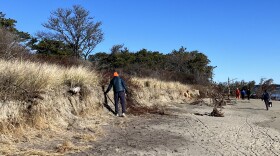Vermont escaped significant damage from flooding this week, Gov. Phil Scott said Tuesday afternoon. But the heavy rain and snowmelt on Monday served as yet another reminder – in a state still trying to recover from July’s historic flooding – that climate change is here.
“Climate change is real. I don’t think anyone should be surprised about this,” Scott said. “I don’t think we can use the traditional methods of 100-year-storms. We’ve proven with Irene, and the July flooding, and then just five months later another storm…I don’t know how to qualify them at this point.”
For today, major rivers have receded, most emergency shelters have closed, most schools have reopened and rescue teams are packing up and going home, Scott administration officials said during an afternoon press conference.
Here is a map showing our two day storm total precipitation across northern New York into Vermont. We did our best to capture as many reports as possible and appreciate all the help. pic.twitter.com/LLDfIvlsFa
— NWS Burlington (@NWSBurlington) December 19, 2023
But many homes and businesses still trying to recover from July are once again dealing with flooding. The worst damage appears to be in Waterbury and the Okemo and Mad River valleys, Secretary of Commerce and Community Development Lindsay Kurrle said.
Homes and businesses in Montpelier and parts of Lamoille County also saw significant flooding, Kurrle said.
“Seeing homes and businesses surrounded by water once again has been heartbreaking,” Scott said. “I feel for those who are just getting back from this summer’s flooding and are now dealing with water in their homes and businesses. I can’t imagine the toll that has on anyone.”
Swift water rescue teams performed 12 rescues this week – three people were pulled from a home in Jamaica, and nine were saved from vehicles caught in moving water across the state, Public Safety Commissioner Jennifer Morrison said. Only two of the initial seven rescue teams deployed in the storm – one in Colchester and the other in Waterbury – remain active, and they plan to pack up later today, Morrison said.
There have been no reported deaths or injuries tied to the flooding, Morrison said.
Seven state roads remain closed, Secretary of Transportation Joe Flynn said. (They are Route 7 in Milton, Route 116 in South Burlington, Route 12 in Berlin, Route 302 from Barre to Orange, Route 109 from Cambridge to Waterville, Route 15 in Cambridge, and Route 14 in Hardwick.)
Six school districts were closed today, mostly because bus routes were cut off by road closures, Interim Secretary of Education Heather Bouchey said. All plan to reopen Wednesday.
Find flood updates from Vermont Public here.
Generally, the flood damage appears to be more widespread, but far less severe, than Vermont suffered in July.
“It maybe touched more people, but wasn’t as intense,” Scott said.
Many of the most well-known problem spots from this summer’s flooding emerged relatively unscathed this week. Mobile homes across Vermont appeared to have sustained little damage. The Wrightsville Dam and other dams in the Winooski River corridor are well below overflow levels. The Johnson wastewater plant saw some flooding, but is still operating normally.
State officials said they were shifting into a “recovery and assessment mode” on Tuesday, with a focus on cleaning and repairing culverts and other stormwater infrastructure as fast as possible.
“We’re going to see more of these intense storms,” Scott said.
Have questions, comments or tips? Send us a message.





